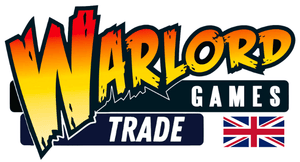Products
-
US Army Jeep with 30 Cal MMGIn June 1940 the American army asked for a vehicle that could "go-anywhere". The answer was the four-wheel drive Willys MB and the Ford GPW, both models referred to as 'Jeeps'. 630,000 jeeps were produced by the end of the war. Cost: 32pts (inexperienced),...
-
US Army starter armyOne of the best-equipped armies in the world at the time, the Americans took on, and beat, their German, Italian and Japanese adversaries. This boxed set contains a great starting point for a force of US Army troops in uniforms ideal for service in...
-
US Army support groupThis set contains: 1 x US Army HQ 1 x US Army Medium Machine Gun Team 1 x US Army Medium Mortar Team HQ American forces started the war with no experience of combat and often with minimal training. Once exposed to the realities...
-
US Army Veterans Squad (Winter)Due to the relatively short amount of time at the front, and particularly because of the constant influx of replacements, regular US infantry units never got quite as ‘seasoned’ as those of some other countries that lacked the American manpower, training and organisation. But...
-
US Firefly Jump InfantryUsing revolutionary jump-packs, Firefly infantry are drawn from the Paratroopers and specialise in rapid advances to take ground, waiting for conventional infantry and armour to relieve them. The US army tactical doctrine placed great emphasis on firepower and mobility, and this is reflected in...
-
US Jackal WalkerThis box contains: Enough resin and metal to create one Jackal A breakthrough in the power of repulsor pods led to first the Jackal and then the Mudskipper walkers, built to keep up with fast moving jump infantry. The M5A5 Jackal sacrifices firepower for speed...
-
US Kodiak WalkerAs the US developed walker tactics for regiments of Grizzly and Bruin walkers it became apparent that an antiaircraft capability was required; wheeled and tracked systems were unable to coordinate with the walkers in urban or close terrain. The Kodiak was the result, reducing...
-
US Mudskipper Jump WalkerThe Mudskipper is one of the newest walkers off the production line, a heavier platform to give the jump infantry some genuine punch as they advance in to enemy territory. With shock absorbers to handle the jumping manoeuvre and a stripped down chassis to...
-
US Paratrooper SquadSt. Mère Eglisé. Carentan. Nijmegen. Bastogne. Actions that stir the blood and conjure images of highly-trained US paratroopers punching holes in the German lines in Normandy and later holding off overwhelming opposition in the Ardennes. These US Airborne models are ideal to represent the 101st...
-
US/Allied LVT-4 "Buffalo" AmtracThe Landing Vehicle Tracked (LVT) was a small amphibious landing craft, introduced by the United States Navy, Marine Corps and Army during World War II. The LVT-4 Buffalo was by far the most numerous version, with over 8,000 vehicles produced. Although conceived to ferry...
-
USS ConstitutionUSS Constitution was one of six Heavy Frigates commissioned by the United States Congress in 1794 to protect American shipping against Barbary Pirates in the Mediterranean. These frigates were designed to outmatch the frigates of any other nation while remaining nimble enough to slip...
-
Valentine II infantry tankThe Valentine tank was a tough and reliable workhorse of the Commonwealth and Soviet armies. Though superseded by the Churchill and Sherman on the Western Front, the 16-ton machine was also used by New Zealand forces in the Far East and continued to be...
-
Veteran Grenadiers SquadFighting to stave off the massed assaults of the Allies on the Eastern and Western Fronts, these battle- hardened German soldiers are armed with the deadly Sturmgewehr 44 assault rifle. Providing dogged resistance from hedgerows and shattered towns, they fight for every inch of...
-
Victory at Sea - AkagiOriginally laid down as an Amagi-class battlecruiser, the stipulations of the Washington Treaty resulted in her conversion to an aircraft carrier. As a result, Akagi (赤城, "Red Castle") was one of Japan’s first large aircraft carriers. Akagi and her near-sister Kaga straddled the line...
-
Victory at Sea - HMS HoodAt one time, the HMS Hood was the largest and possibly most famous ship in the world, representing the supremacy of British sea power. Though attached to Home Fleet, the Hood took part in the sinking of the French fleet at Oran. She was...
-
Victory at Sea - IJN Submarines & MTB sectionsSubmarines: The Kaidai-7-class, or KD-7, was developed in the late 1930s, following on from the preceding KD-6 class. With a surface range of 8,000nm at 16kts, and a submerged endurance of 50nm at 5kts, they possessed a slightly better underwater performance to the late-model...
-
Victory at Sea - Kriegsmarine U-Boats & MTB sectionsSubmarines: A long-ranged submersible, the Type IX was the most successful U-boat of the war, with each vessel averaging over 100,000 tons of shipping sunk. One Type IX, U-107, made the most successful convoy mission of the war, with nearly 100,000 tons of shipping...
-
Victory at Sea - Merchant ConvoyPreventing attacks on defenceless merchant ships is the other main role of the navy, and it was here that the war was fought, day in and day out, by the humble corvette, frigate and destroyer escort, and later by escort carriers. Commerce raiding formed...
-
Victory at Sea - Royal Navy Submarines & MTB sectionsSubmarines: Designed for use in North European and Mediterranean waters, the S-class was manoeuvrable with a noted ability to crash dive extremely quickly. Combined with a large salvo of torpedoes, this was a successful design of pre-war years that was soon updated and put...
-
Victory at Sea - US Navy Submarines & MTB sectionsSubmarines: The Gato-class of submarine was the first mass production US submarine class of the Second World War, forming the majority of the United States Navy’s submarine fleet of the war. It was the Gato-class, and the successors of her design that were largely...








































